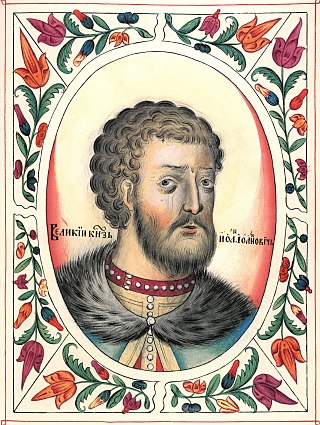
Ivan II Ivanovich the Fair was the prince of Moscow and grand prince of Vladimir in 1353. Until that date, he had ruled the towns of Ruza and Zvenigorod. He was the second son of Ivan Kalita, and succeeded his brother Simeon the Proud, who died of the Black Death.

The Moskva is a river running through western Russia. It rises about 140 km (90 mi) west of Moscow and flows roughly east through the Smolensk and Moscow Oblasts, passing through central Moscow. About 110 km (70 mi) southeast of Moscow, at the city of Kolomna, it flows into the Oka, itself a tributary of the Volga, which ultimately flows into the Caspian Sea.
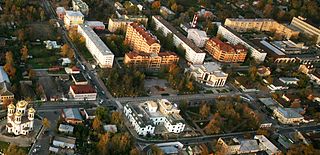
Zvenigorod is a town in the Moscow Oblast of western Russia. In 2010 it had a population of about 16,000.

Dmitriy Yurievich Shemyaka was the second son of Yury of Zvenigorod by Anastasia of Smolensk and grandson of Dmitri Donskoi. His hereditary patrimony was the rich northern town Galich-Mersky. When his brother prince Vasily I of Moscow died in 1425, he and his 10-year-old nephew Vasily started fighting over the right to the throne, causing the Muscovite War of Succession (1425–1453). Intermittently, Shemyaka managed to be recognised twice as Grand Prince of Moscow.(1445, 1446–1447)
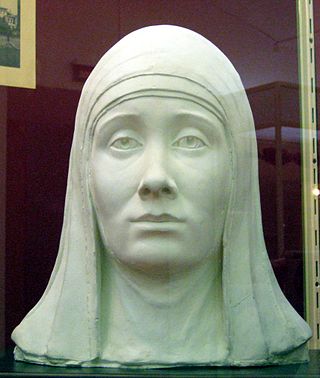
Eudoxia of Moscow, also known by her monastic name Euphrosyne, was the grand princess of Moscow during her marriage to Dmitry Donskoy.
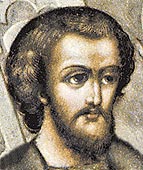
Yury Dmitrievich, also known as George II of Moscow, Yury of Zvenigorod and Jurij Zwenihorodski, was the second son of Dmitri Donskoi. He was the Duke of Zvenigorod and Galich from 1389 until his death. During the reign of his brother Vasily I, he took part in the campaigns against Torzhok (1392), Zhukotin (1414), and Novgorod (1417). He was the chief orchestrator of the Muscovite Civil War against his nephew, Vasily II, in the course of which he twice took Moscow, in 1433 and 1434.

Belorussky railway station also referred to as Moscow–Passenger–Smolenskaya, Informally the whole station can be called as Moscow Belorusskaya, is a railway terminal of the Moscow Railway located at the front of Tverskaya Zastava Square in Central Administrative Okrug, Moscow. The station is one of nine railway terminals of Moscow. It was opened in 1870 and rebuilt in its current form in 1907–1912.

Lyudmila Grigoryevna Postnova is a former Russian handball player for, who last played for HC Astrakhanochka and the Russian women's national handball team. Postnova is considered one of the greatest Russian players of all time.
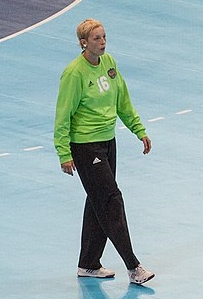
Mariya Igorevna Sidorova is a Russian handball player, playing on the Russian women's national handball team. She won the gold medal with the Russian winning team in the 2007 World Women's Handball Championship. She played for 11 years in Lada Togliatti, before moving to Zvezda Zvenigorod in Summer 2012.

The Savvino-Storozhevsky Monastery is a Russian Orthodox monastery dedicated to the feast of the Nativity of the Theotokos. It is the preeminent landmark of Zvenigorod, a town located 48 km (30 mi) west of Moscow.

Zvezda Zvenigorod is a Russian women's handball club from Zvenigorod, near Moscow. They won the Champions League and the Champions Trophy in 2008, and the EHF Cup in 2006/07. Between 2006 and 2011 the club was coached by Russian national team trainer Evgeny Trefilov. In the summer of 2011 he was replaced by head coach Zdravko Zovko.
Semen Hryhorovych Hryzlo was a Ukrainian military and civil activist, one of the organizers of the Free Cossacks military formations, and a participant in the uprising on the battleship Potemkin.
The 2010 Russian Women's Football Championship was the 19th edition of the top division in Russian women's football. The competition was doubled from 12 to 24 game weeks, and took place from April 17 — October 17, 2010. For the third year in a row it was contested by seven teams, with Kubanochka Krasnodar replacing disbanded Lada Togliatti to join Energiya Voronezh, ShVSM Izmailovo, WFC Rossiyanka, Ryazan VDV, Zvezda Perm and Zvezda Zvenigorod.
The 2006–07 Women's EHF Cup was the 26th edition of the European Handball Federation's secondary competition for women's handball clubs, running from 14 September 2006 to 20 May 2007. Zvezda Zvenigorod defeated Ikast Bording EH in the final to become the first Russian team to win the competition.
The 2007–08 Women's EHF Cup was the 27th edition of the competition, running from 31 August 2007 to 24 May 2008. Dynamo Volgograd followed the steps of the previous edition's champion Zvezda Zvenigorod as the second Russian club to win the competition, beating SD Itxako in the final.
The 36th Infantry Division was an infantry formation of the Russian Imperial Army.
The 2007 EHF Women's Champions Trophy was the 12th edition of the EHF Super Cup in new format. It started on 22 September 2007.

The Belorussky suburban railway line is one of eleven railway lines used for suburban railway connections between Moscow, Russia, and surrounding areas, mostly in Moscow Oblast. The Belorussky suburban railway line connects Moscow with the stations in the west, in particular, with the towns of Odintsovo, Golitsyno, Zvenigorod, Kubinka, and Mozhaysk. The stations the line serves are located in Moscow, as well as in Odintsovo, Ruza, and Mozhaysk in Moscow Oblast. Some of the suburban trains have their eastern terminus at Moscow Belorussky railway station in Moscow, others commute from the Savyolovsky suburban railway line. In the western direction, the suburban trains terminate at Usovo, Odintsovo, Golitsyno, Zvenigorod, Kubinka I, Dorokhovo, Mozhaysk, and Borodino. The line is operated by Moscow Railway. The tracks between Moscow Belorussky railway station and Odintsovo are also used by Line D1, one of the Moscow Central Diameters, and by the service to Sheremetyevo International Airport, provided by Aeroexpress.

Egor Ivanovich Makovsky was a Russian accountant and artist, one of the founders of the forerunner of the Moscow School of Painting, Sculpture and Architecture.

The Rublyovo-Uspenskoye Highway, designated as A106, is a Russian federal highway that runs from Moscow to Zvenigorod. It starts at the Rublevsky Highway at the intersection with the Moscow Ring Road, runs along the Moskva river and ends near Zvenigorod.














